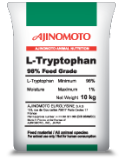As the balance of amino acids improves with the inclusion of L-Lysine, DL-Methionine and L-Threonine and the subsequent reduction in the amount of excess amino acids, Tryptophan generally becomes the next limiting amino acid. Although Tryptophan constitutes a relatively small portion of the feed, corn is low in Tryptophan and corn-soy diets become limiting in Tryptophan.
Using modern selection techniques, bacteria have been developed which produce L- Tryptophan during fermentation. By selecting higher yielding organisms and improving production methods, L-Tryptophan is now commercially available for use in animal feeds.
In addition the need for maintenance and lean body tissue accretion, Tryptophan is also involved in other metabolic systems. Firstly, with serotonin (a neuro-mediator in the brain) which is derived from Tryptophan, and because of this relationship Tryptophan has been fed at higher levels to calm animals in stress conditions. Secondly, the vitamin niacin can also be synthesized from Tryptophan, although not at a sufficient rate to meet the niacin requirements of the animal.

